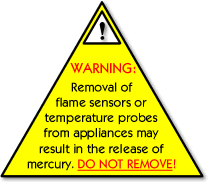 |
| MERC home > proper disposal > flame sensors & temperature probes |
Disposal of Mercury-Containing Flame Sensors and Temperature ProbesMercury-containing flame sensors and temperature probes may be found in gas-fired appliances. A flame sensor or temperature probe consists of a metal bulb and thin tube attached to a gas-control valve. The mercury is contained inside the tube and expands or contracts to open and shut the valve. Mercury is contained in the probe and capillary tube on the device. Do not attempt to remove the capillary tube from the device or even the device from the appliance to avoid the release of mercury. These devices should not be disposed of in the regular trash. The information below will:
Identifying Mercury-Containing Flame Sensors and Temperature ProbesSeveral types of gas-fired appliances that have pilot lights may have mercury-containing flame sensors or temperature probes including:
Some non-mercury flame sensors have been used in these appliances, but you should treat all sensors as if they contain mercury, unless you are certain they don't. Alternatives AvailableNewer model appliances use an electronic igniter or electronic flame sensor. If there is no available electricity to the appliance such as in recreational vehicles and residences without electricity, there may be no non-mercury alternative at this time. Disposal InformationHouseholds
|
|
|
||||||||
|
MERC Home | mercury
facts | mercury in fish
| environmental concerns |
statutes & regulations | mercury-added
product manufacturer requirements Mercury Education & Reduction Campaign |

 The appliances listed above are referred to as "white goods"
and have been banned from disposal in Vermont landfills. To dispose of white goods:
The appliances listed above are referred to as "white goods"
and have been banned from disposal in Vermont landfills. To dispose of white goods: